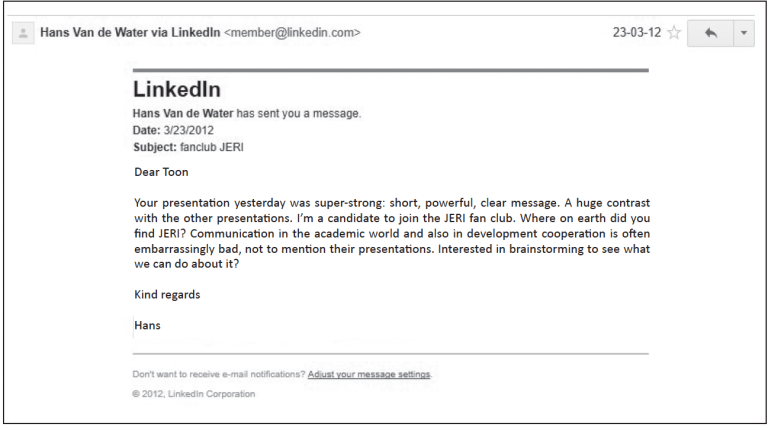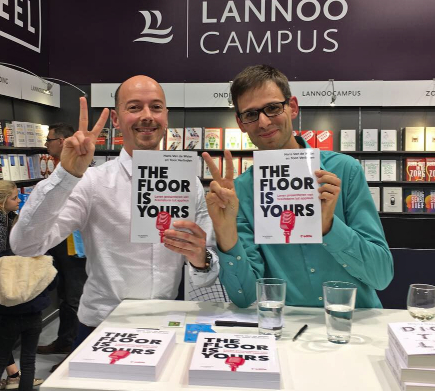How a five-minute presentation changed our lives
If anyone tells us that presentations don’t make an impact, we answer them about the five-minute presentation that changed our lives. This is the story of how we – Toon Verlinden and Hans Van de Water – created The Floor is Yours, because we believed ‘life is too short for bad presentations’. This is what happened.
Toon:
I am an industrial biochemical engineer and journalist by training. In 2009, I started work as the Research and Science Communication Officer at a university college. During that job I soon came into contact with a water purification project in Ghana, which I was keen to support. At the start of 2012, the Flemish Government asked me if I would be interested in giving a presentation about the project on World Water Day. Interested? You bet!
I had been working three years on the project; it was my passion. And I was expected to say something meaningful about it in five minutes?
Not long after, the mail with practical information arrived and hard reality set in: ‘You will have five minutes to present your project’. Five minutes! I blinked twice and looked at the mail again. No, still five minutes. I had been working three years on the project; it was my passion. And I was expected to say something meaningful about it in five minutes? Not easy! There were at least four other speakers before and after me. It promised to be a real battle to get and keep the public’s attention.
What did I really want to tell them? I took out a notepad and made a list. Something about Ghana and its culture; something about the local need for drinking water; something about the installations; something about the partners we work with; something about the purification techniques; and, of course, something about our fundraising activities in Belgium to pay for it all. After this mini-brainstorming session, I had a list of thirteen subjects.
Thirteen subjects in a five minute presentation? That’s about 23 seconds a subject. Impossible! I needed to cut down my list. My World Water Day public wanted to hear something about water, so that had to stay in. But Ghanaian culture and Belgian fundraising? They could go. I kept on whittling down until I was left with just three subjects. I decided that I would start my presentation with a slide explaining to the public that I didn’t have the time to give them the full story, but only the most relevant parts of it. I called the slide JERI because I was giving the public ‘Just Enough Relevant Information’.
This was my way of saying that the project was much broader than what I could show and also an excuse for not being able to deal with other – in my eyes – important information.
People laugh when I show them the JERI slide. They understand I can’t tell them everything and are happy I stick to the allotted time.
22 March. World Water Day. The floor is mine. People laugh when I show them the JERI slide. They understand I can’t tell them everything and are happy I stick to the allotted time. I talk about the two installations we have built and the different partners we work with. The audience listens attentively and gives me a good round of applause at the end. The public and the organizers are both happy because they have learnt a few interesting things in a short space of time. Mission accomplished. I return to my chair. ‘That’s me done for the day’, I thought. What I didn’t know was that somewhere in the audience a certain Hans Van de Water was sitting.
Hans:
To be honest, I was destined to spend my life in development work. Even as a teenager, my budding social conscience knew that there was something fundamentally wrong with the balance of our planet. I studied political sciences, was active in all different kinds of social organizations and for my thesis, went to the Mexican rainforests to research the impact of an internal conflict.
After a number of years working for an NGO, in 2006 I joined VLIR-UOS, an organization promoting collaboration between universities and university colleges in Flanders with their counterparts in Africa, Asia and Latin America. I had long been interested in scientific research, but in my new job I discovered how science could change the world. As the Communications Officer, I was not only responsible for projecting the external image of VLIRUOS, but also for helping researchers to tell their own stories. And that’s where things so often went wrong.
A pattern soon began to emerge: behind the scenes, the researchers were great storytellers, but once they were on stage they became boring and unclear.
I regularly organized events about the projects we financed. Naturally, I chose the things that had achieved fantastic results. Sadly, a pattern soon began to emerge: behind the scenes, the researchers were great storytellers, but once they were on stage they became boring and unclear. Result? A series of presentations that made no-one happy. In fact, I saw the same thing at all the other events I attended. Why was it so hard to give good presentations?
It frustrated me enormously. All those useless presentations must be costing society a fortune, without giving anything back in return.
In 2012, I helped to organize World Water Day. I suggested inviting a number of researchers to talk about their practical experiences. But it had to be short and powerful.
And then – Toon comes on stage. I can feel immediately that this is going to be different. He smiles and starts with JERI: Just Enough Relevant Information. ‘Hey,’ I think to myself, ‘That’s a smart idea!’
I can still remember that day. One speaker after another got lost in a mass of meaningless data. It was a good job they only had five minutes; at least the pain was short-lived. And then – Toon comes on stage. I can feel immediately that this is going to be different. He smiles and starts with JERI: Just Enough Relevant Information. ‘Hey,’ I think to myself, ‘That’s a smart idea!’
The five minutes fly by. Wow! So it is possible after all: clear and convincing. I’m impressed. That’s the way everyone should give presentations.
Toon:
The day after World Water Day, a LinkedIn message from Hans arrives in my mail box. He lets me know that my performance was ‘super-strong’ and that he wants ‘to join the JERI fan club’. He asks if we can meet to brainstorm about what can be done to improve academic presentations, which, in his opinion, are ‘often embarrassingly bad’.

I am more than happy to agree. We sit together for an hour in Brussels and immediately start making plans. Just weeks later we start a blog with presentation tips for researchers. We call it The Floor is Yours because everyone can learn what to do on stage to give strong presentations.
Our motto: ‘Life is too short for bad presentations’.
Hans:
The result? The Floor is Yours was started in October 2012 as a platform to help scientists and anyone else with a complex message to create and deliver clear and convincing presentations. We were – and still are – certain that science and knowledge can change the world, but not with boring and difficult to understand presentations. This belief is reflected in our motto: ‘Life is too short for bad presentations’.
Soon after our first blog post, we were asked if we would like to organize workshops. Of course, we did! That set the ball rolling. We now give training to universities, university colleges and at congresses, but also to companies, government organizations and hospitals in Belgium, the Netherlands, Portugal, Italy and Mexico.
In the meantime, we have helped thousands of professionals and researchers. Hopefully, this book will now help you. Perhaps you can find your way on your own or perhaps we have lowered the threshold for you to attend a workshop?
All our experience from workshops, combined with extensive knowledge from the professional literature, is now combined in our book ‘The floor is yours’.
